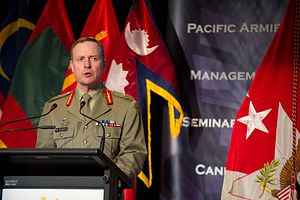I recently heard the most compelling speech I’ve ever heard on behalf of a strong navy. It came from a top navy army officer representing America, the world’s foremost seafaring state, in Australia, a middleweight power along maritime Asia’s southern flank, and was given in Newport Sydney. Scope out this address from General David Morrison, the Australian Army chief of staff:
Leave it to ground-pounders from Down Under!
Startlingly, General Morrison takes his lead from Mahan of blessed memory. The maritime pundit’s six determinants of sea power indicate which societies can take to the briny main for fun, profit, and strategic gain. Or maybe Mahan isn’t such a strange north star. By his standards, Australia represents a hybrid seafaring/continental nation, much like the United States before the Spanish-American War (1898). That is, it’s like the America whose seafaring spirit Mahan wrote to arouse.
That commends him to Australian maritime advocates. Nineteenth-century America was a big, largely insular, thinly populated country gifted with oceanic buffers. It was a middle power remote from Eurasian tumults. So is Australia.
The United States prospered during the Industrial Revolution, amassing the wealth and industrial might to construct a great navy. That gave the republic the capacity to manage regional waters. The analogy maps imperfectly to contemporary Australia, whose arms industry remains far from self-sufficient. Still, Australia too can shape events in its near abroad, mainly the Bay of Bengal, the South China Sea, and the South Pacific. Canberra sees little need to compete head-to-head with leading sea powers. Americans, likewise, long contented themselves with taking second place to Great Britain and its Royal Navy. Only in 1916, with world war raging in Europe, did Washington resolve to field a “navy second to none.”
Morrison makes another point. Big, isolated countries are peculiarly prone to “sea blindness.” Think about it. Continental states can choose to turn inward. They can, but need not, venture seaward in quest of prosperity. Modest, largely passive defenses against seaborne threats may suffice. If the Everyman sees little visible return on his investment in shipbuilding, budget-conscious lawmakers are prone to skimp on it.
The myopia problem is particularly acute in lands once ruled by the British Empire. Whatever the failings of colonial rule, the Royal Navy safeguarded the shipping lanes while fending off invasions and other threats from the sea. That let subject peoples free-ride on British-supplied maritime security rather than invest in oceangoing fleets of their own. Policing the sea, assumed Australians, Indians, and Americans, was something someone else did — until it wasn’t. Yet free-riding habits of mind die hard.
Or maybe they have to be slain. Sea power, it seems, is an idea. It’s more than just ships, aircraft, mariners, or tactics. And since nautical pursuits are remote from everyday life, a seagoing culture must be consciously, constantly nourished and refreshed. The good news for Australia is that combating sea blindness appears to be a truly joint project. In Sydney, not just the army chief but the commander of the Australian Air Force, Air Vice Marshal Mel Hupfeld, commented knowledgeably about how land-based forces support Royal Australian Navy task forces ranging across the seas.
Lean times invariably and occasionally pit the U.S. armed services against one another in unseemly feuding cordial debate over how to parcel out the defense budget. To this outsider, at least, it appears that such rivalries are muted in Australia. Why? Superior virtue? Doubtful. Maybe it’s that middle powers destined to remain middle powers — Australia, unlike the United States, lacks the makings of maritime supremacy — must use finite resources wisely. A house divided among rival services is apt to fall when funding is short. Such prospects concentrate minds.
The nation’s middle status simplifies life for the Australian military in other ways. The Australian Air Force, for instance, need not concern itself with strategic missions such as nuclear deterrence or long-range bombing — missions that fuel infighting over roles, missions, and budgets even within the U.S. Air Force. (Nor is the U.S. Navy immune to internal rivalry.) Simplicity of purpose lets airmen focus on the Australian near abroad, a largely marine milieu, and on tactical air power. The service, it appears, conceives of itself as a quasi-maritime service. As for the Australian Army, the imperative to manage that near abroad — a legacy of East Timor and other enterprises — begets an expeditionary mindset hospitable to maritime power in its broadest sense.
The examples of Australia and other middle powers are worth studying as the United States battles its own case of sea blindness. Identifying similarities and differences while revisiting America’s own middle-power past may help sea-service officials grind corrective lenses. Here’s hoping they get the prescription right.

































